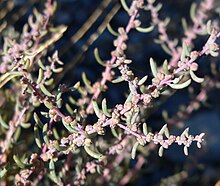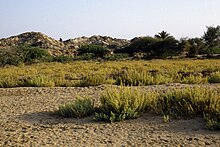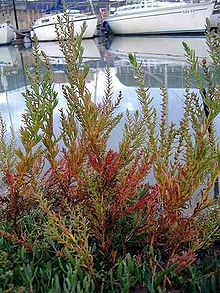| Suaedoideae | |
|---|---|

| |
| Suaeda nigra | |
|
Scientific classification
| |
| Kingdom: | Plantae |
| Clade: | Tracheophytes |
| Clade: | Angiosperms |
| Clade: | Eudicots |
| Order: | Caryophyllales |
| Family: | Amaranthaceae |
| Subfamily: |
Suaedoideae Ulbr. |
| Genera | |
|
about 2 genera, see text | |
The Suaedoideae are a subfamily of plants in the family Amaranthaceae (now including the former family Chenopodiaceae).
Description
The Suaedoideae have well-developed leaves. Except for genus Bienertia, the leaves show a central and many lateral vascular bundles. The leaves are neither decurrent nor amplexicaul.
The inflorescences are axillary cymes. The flowers are sitting free in the axils of bracts, with lateral bracteoles. The perianth consists of 5 tepals, which are more or less fused basally. 5 stamens are present. The seed encloses a spiral embryo, mostly without any perisperm.
Distribution
The Suaedoideae have a nearly worldwide distribution. They are important members of the vegetation of shores and salty inland habitats. They are especially common in dry (arid) regions.
Photosynthesis pathway
Among the species of Suaedoideae, there are nearly equal numbers of C3-plants and C4-plants. During the evolution of the subfamily, the C4-photosynthesis pathway seems to have been derived from four independent origins: two times with Kranz C4 anatomy in Suaeda section Salsina and Suaeda section Schoberia. Two independent origins of non-Kranz C4 systems are found in Bienertia and Suaeda section Borszczowia. In these plants, the photosynthesis pathways are located without spatial separation in a "single cell C4" type. [1]
Systematics


According to phylogenetic research by Kapralov et al. (2006), the Suaedoideae are grouped in 2 tribes:
- Tribus
Bienertieae Ulbr., with only one genus:
-
Bienertia Bunge ex Boiss., with 3 species:
- Bienertia cycloptera Bunge ex Boiss. [2]
- Bienertia sinuspersici Akhani [3]
- Bienertia kavirense Akhani [4]
-
Bienertia Bunge ex Boiss., with 3 species:
- Tribus Suaedeae, with only one genus:
See also
References
- Kapralov, Maxim V.; Akhani, Hossein; Voznesenskaya, Elena V.; Edwards, Gerald; Franceschi, Vincent; Roalson, Eric H. (2006). "Phylogenetic Relationships in the Salicornioideae / Suaedoideae / Salsoloideae s.l. (Chenopodiaceae) Clade and a Clarification of the Phylogenetic Position of Bienertia and Alexandra Using Multiple DNA Sequence Datasets". Systematic Botany. 31 (3): 571–585. doi: 10.1600/036364406778388674.
- ^ Kadereit, G.; Borsch, T.; Weising, K.; Freitag, H. (2003). "Phylogeny of Amaranthaceae and Chenopodiaceae and the Evolution of C4 Photosynthesis". International Journal of Plant Sciences. 164 (6): 959–986. doi: 10.1086/378649. S2CID 83564261.
- ^ Akhani, H.; Ghobadnejhad, M.; Hashemi, S. M. (2003). "Ecology, Biogeography and Pollen Morphology of Bienertia cycloptera Bunge ex Boiss. (Chenopodiaceae), an Enigmatic C4 Plant without Kranz Anatomy". Plant Biology. 5 (2): 167–178. doi: 10.1055/s-2003-40724.
- ^ Akhani, Hossein; Barroca, João; Koteeva, Nuria; Voznesenskaya, Elena; Franceschi, Vincent; Edwards, Gerald; Ghaffari, Seyed Mahmood; Ziegler, Hubert (2005). "Bienertia sinuspersici (Chenopodiaceae): A New Species from Southwest Asia and Discovery of a Third Terrestrial C4 Plant Without Kranz Anatomy". Systematic Botany. 30 (2): 290–301. doi: 10.1600/0363644054223684. S2CID 85946307.
- ^ Akhani, H.; Chatrenoor, T.; Dehghani, M.; Khoshravesh, R.; Mahdavi, P.; Matinzadeh, Z. (2012). "A new species of Bienertia (Chenopodiaceae) from Iranian salt deserts: A third species of the genus and discovery of a fourth terrestrial C4 plant without Kranz anatomy". Plant Biosystems. 146 (3): 550–559. doi: 10.1080/11263504.2012.662921. S2CID 85377740.
- ^ a b c Schütze, P.; Freitag, H.; Weising, K. (2003). "An integrated molecular and morphological study of the subfamily Suaedoideae Ulbr. (Chenopodiaceae)". Plant Systematics and Evolution. 239 (3–4): 257–286. doi: 10.1007/s00606-003-0013-2. S2CID 20250636.